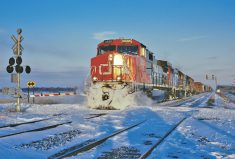It’s a classic “chicken” scenario, with both sides waiting to see whether the other caves first.
Fertilizer retailers, stuck with overpriced inventories bought during last summer’s market peak, are hoping that the fear of shortages amidst the seeding rush will force farmers to start cutting cheques.
Farmers, on the other hand, are holding out for the best deals.
Holding off on fertilizer purchases last summer and fall when prices were sky high was a good move, according to Roger Larson, president of the Ottawabased Canadian Fertilizer Institute.
Read Also

Mazergroup’s Bob Mazer dies
Mazergroup’s Bob Mazer, who helped grow his family’s company into a string of farm equipment dealerships and the main dealer for New Holland machinery in Saskatchewan and Manitoba, died July 6 from cancer.
But waiting much longer to secure supplies ahead of spring seeding may not be a great plan.
Fall fertilizer application in Manitoba was an estimated 40 per cent lower than in previous years, as farmers adopted a wait-and-see attitude to see if the future might hold better bargains, or if grain prices might stage a recovery rally, he said.
If grain prices fall even further, and farmers opt to cut back on their fertilizer rates, then retailers may have to eat their losses.
EAT LOSSES
But if fertilizer demand stays at normal levels, product will have to move before spring, and those who waited too long may get lost in the frenzy, as the supply chain – which even in normal years groans under the strain – is pushed to the breaking point.
“Many retailers were caught with significant unanticipated inventories as a result of the
“The system, whether from the manufacturing side or retail, is absolutely jammed and there are all different levels of pricing out there.”
– ROGER LARSON, CFIPRESIDENT
sudden shift in markets,” he said, in a presentation at the annual Man-Dak Zero-Till Association workshop in Brandon last week.
“It’s going to take some time for current inventories to move through the system. Buyers and sellers will have some serious choices to make in negotiating supply arrangements going forward.”
Storage capacity, labour supply, the availability of trucks and drivers, will all have an impact on whether the logistical chain can supply farmers with product on time or becomes jammed in a last-minute demand stampede, he added.
Judging by company reports, the situation elsewhere in Canada mirrors that of Manitoba, and he estimated that an extra million tonnes will have to move in the second half of the year unless demand falls dramatically.
“The system, whether from the manufacturing side or retail, is absolutely jammed and there are all different levels of pricing out there. If grain prices keep going lower, fertilizer production curtailment probably won’t be a factor,” he said.
“But if grain prices bounce, watch out, because there won’t be enough fertilizer.”
REAL DRIVERS
In a global market, the impact of China and India – which he described as the real drivers of fertilizer demand with two billion citizens to feed – was felt last year amid a panic over low grain stocks.
China slapped a 110 per cent export tax on fertilizer, and India’s subsidy programs left the government covering a $23 billion tab.
Then last July, oil prices crashed from $147 a barrel, signalling an end to the commodity bull market which was followed by the double whammy of a full-blown financial crisis in the fall.
Fertilizer manufacturers, who typically start building inventories nearly a year in advance of the spring rush, had no indication that the bubble was about to burst.
Retailers were left holding the bag. Caught up in the hype, they rushed to fill storage capacity just before the market meltdown that began in September.
Farmers, faced with uncertain demand for grain, have sat on their wallets ever since.
“We have an inventory cycle that builds for 11-1/2 months and then goes boom. Retailers moved to ensure a fertilizer supply for farm customers in the summer of 2008, when fertilizer prices were high, but before the financial crisis,” said Larson.
“Not only were fertilizer prices high, but there was a lot of discussion as to how much higher they would go. Before the financial meltdown, nobody could see the end of the road for either grain or fertilizer.”
CHEAP SHOTS
Larson, when asked about “collusion” in the fertilizer industry, which is dominated by a handful of giant international companies, said that the industry believes in free trade. He also dismissed criticism by pundits and environmentalists as “cheap shots.”
“We don’t have any import tariffs in North America. Anybody who wants to import fertilizer is able to do so,” said Larson.
“So when you talk about ‘collusion,’ that would probably be the dumbest way to set up a market that you can control and protect.”
Global fertilizer production capacity will remain tight, he added, especially with regard to phosphorus. The high-grade portions of Florida’s mammoth deposit are gone, and delays in bringing a new megaproject in Saudi Arabia online have left the future supply-demand picture in question.
Canada’s potash supplies are likely good for another 1,000 years at current production levels, he said. Whether nitrogen fertilizer production in Canada remains competitive depends on the price and availability of natural gas domestically compared to that of low-cost Middle Eastern producers. [email protected]


















